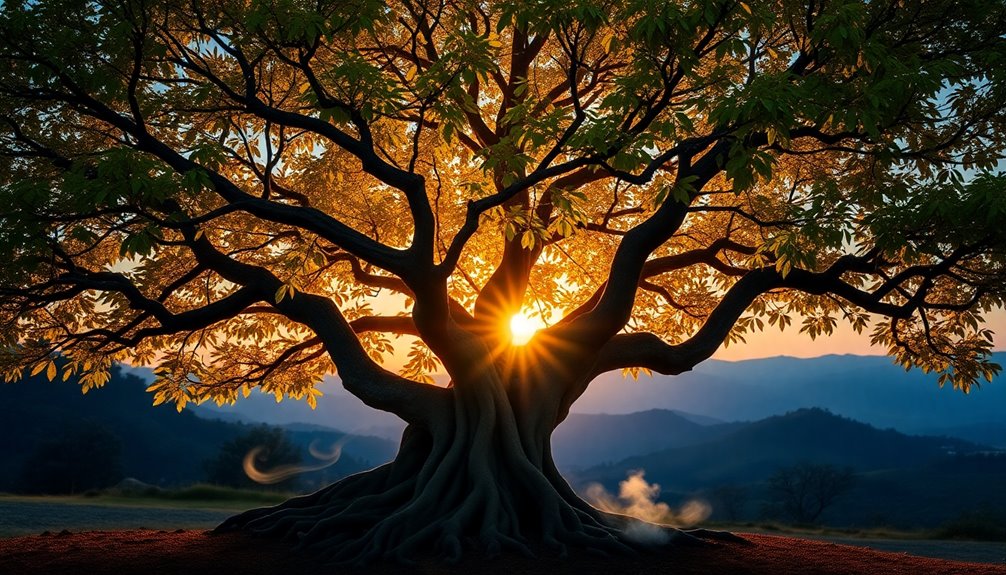The Tree of Life meaning revolves around the interconnectedness of all living things. It embodies life, growth, and resilience, symbolizing cycles of birth, death, and rebirth. Across various cultures, it represents spiritual enlightenment and fulfillment. In biblical texts, it signifies eternal life and wisdom, while ancient civilizations viewed it as a connection to ancestry and community. The Tree's branches remind you of the importance of personal and collective growth. It's more than just a symbol; it's a reflection of harmony and balance in life. Discovering its rich meanings can deepen your understanding even further.
Key Takeaways
- The Tree of Life symbolizes interconnectedness among all living things, representing growth, resilience, and continuous self-discovery.
- In biblical texts, it signifies eternal life, wisdom, and spiritual fulfillment, notably in Genesis and Revelation.
- Various cultures interpret the Tree of Life differently, linking it to abundance, immortality, and ancestral connections.
- It illustrates the importance of community and relationships, emphasizing balance and harmony in personal and collective growth.
- Rituals associated with the Tree of Life foster meditation, community bonding, and reflection on abundance and blessings.
Introduction
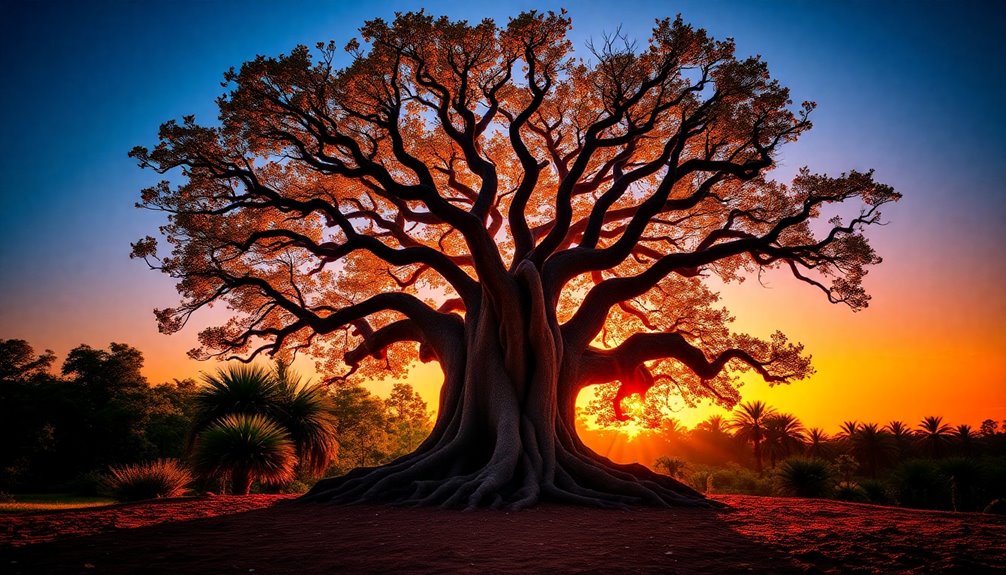
The Tree of Life often serves as a powerful symbol of interconnectedness among all living things. When you think about it, trees embody the essence of life, growth, and resilience. They remind you of the cycles that govern existence, from birth to death and rebirth. Sacred trees, revered in various cultures, often symbolize immortality and spiritual enlightenment, showcasing how deeply rooted connections can foster unity among diverse forms of life.
As you explore the concept further, you'll discover that the Tree of Life is depicted with intricate roots, sturdy trunks, and expansive branches. These elements illustrate the profound relationships that exist within ecosystems.
In artistic representations, like Gustav Klimt's mural, the Tree of Life conveys themes of unity and the connection between different realms of existence. Scientifically, this metaphor also sheds light on evolutionary relationships, revealing how all organisms share a common ancestry.
In essence, the Tree of Life encapsulates the delicate balance of nature and the intricate web that binds us together. By reflecting on its meaning, you deepen your understanding of your place within this grand tapestry of life.
Biblical Tree of Life References
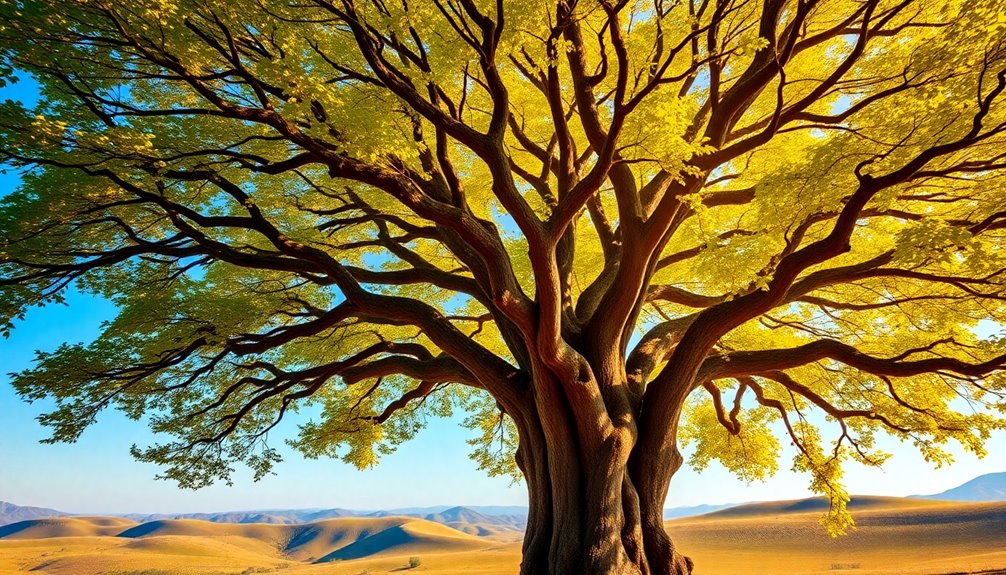
When you explore the biblical references to the Tree of Life, you'll find its significance woven throughout scripture.
From its origins in Genesis to its promise of healing in Revelation, these passages offer rich insights into its meaning.
Let's look at both primary and secondary references to better understand its role in God's narrative.
Primary Bible References
Biblical references to the Tree of Life reveal its profound significance in both the Old and New Testaments. First mentioned in the Book of Genesis, the Tree of Life is situated in the Garden of Eden, symbolizing eternal life and divine sustenance for Adam and Eve (Genesis 2:9).
This imagery shifts dramatically in Genesis 3:24, where God places cherubim to guard the Tree, symbolizing how sin led to humanity's loss of access to eternal life.
Fast forward to Revelation, where the Tree of Life reappears in the New Jerusalem, bearing twelve kinds of fruit and providing healing for the nations (Revelation 22:2). Here, it emphasizes the themes of eternal life and restoration.
Additionally, Proverbs 3:18 likens wisdom to the Tree of Life, showing its connection to spiritual insight and fulfillment.
In Ezekiel 47:12, the imagery of trees along the riverbanks reinforces the Tree of Life's role in providing healing and sustenance, underscoring its importance in biblical eschatology.
These references collectively highlight the Tree of Life's enduring significance throughout scripture.
Secondary Bible References
Throughout scripture, secondary references to the Tree of Life deepen its significance and expand its symbolism. In Proverbs 3:18, wisdom is described as a Tree of Life to those who embrace it, linking the pursuit of wisdom with the sustenance and vitality that the tree represents.
This connection invites you to recognize the importance of seeking wisdom as essential for a fulfilling life.
In Revelation 22:2, the Tree of Life reemerges in the New Jerusalem, bearing twelve kinds of fruit with leaves for the healing of the nations. This imagery reflects a promise of restoration and eternal life, echoing the themes of abundance found in the Celtic Tree of Life, which symbolizes interconnectedness and life's cycles.
Ezekiel 47:12 further reinforces this theme, depicting trees along a life-giving river that produce fruit monthly, embodying the ongoing provision of divine sustenance.
These scriptures collectively illustrate the Tree of Life as a powerful symbol of eternal life, healing, and wisdom, connecting you to the divine narrative that began in the Garden of Eden with the tree of knowledge.
Ancient Civilizations' Tree Symbolism
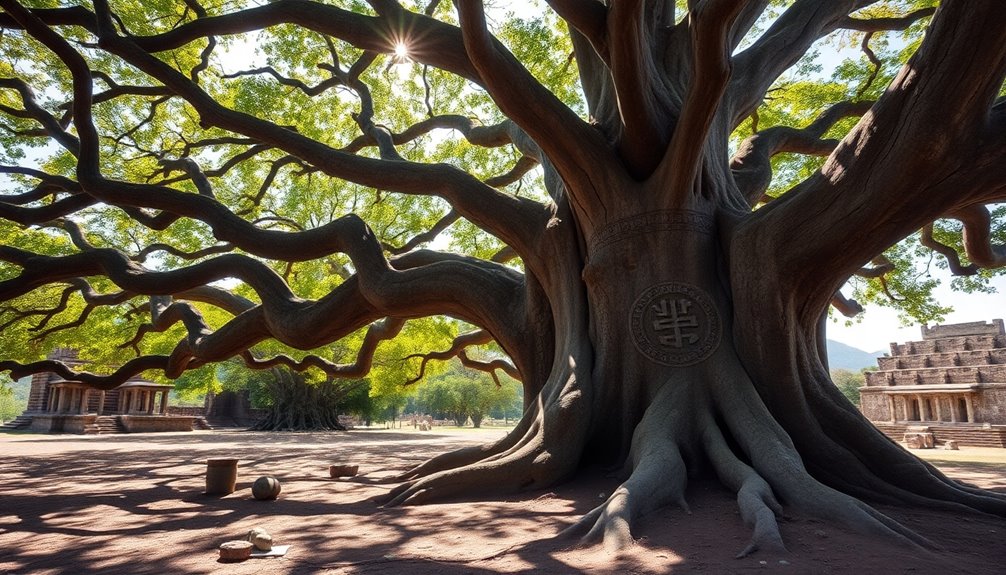
Ancient civilizations often revered trees as powerful symbols, embodying concepts like life, immortality, and divine connection. In Ancient Mesopotamia, the Assyrian Tree of Life, depicted in palace reliefs, illustrates a divine order through its nodes and crisscrossing lines. This tree symbolizes the connection between the sacred and earthly realms, showcasing how trees serve as a source of eternal life.
In the Epic of Gilgamesh, the quest for immortality intertwines with tree symbolism, emphasizing their role in seeking eternal existence.
Moving to Ancient Iran, Avestan literature highlights sacred vegetal icons, with Ameretat representing eternal life. The Gaokerena tree stands as a testament to the continuity of life and the promise of immortality.
In Hinduism, the Kalpavriksha emerges from the churning of the milky ocean, symbolizing abundance and the fulfillment of desires—its revered status showcases the profound knowledge of good associated with trees.
Greek mythology also contributes to this rich tapestry, with golden apples linked to Hera, embodying the themes of forbidden fruit and the pursuit of immortality.
These stories remind you that trees have long been integral to humanity's understanding of life, knowledge, and the divine.
Cultural Significance Across Civilizations
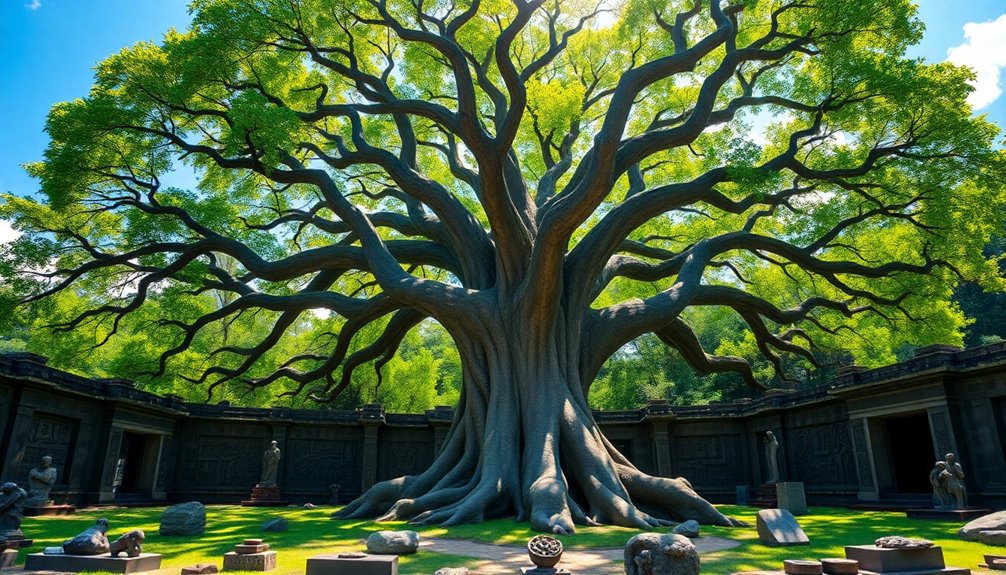
Across various cultures, trees hold deep significance, often symbolizing life, resilience, and connections to the divine. In Ancient Mesopotamia, the Tree of Life was depicted prominently, representing divine order and themes of kingship and immortality. You'd find it intertwined with human or divine figures, emphasizing its importance.
Similarly, the Celtic tradition honors the Crann Bethadh as a sacred tree, a symbol of life and ancestry, linking communities to the Otherworld. In Hinduism, the mythological Kalpavriksha embodies abundance, emerging from the churning of the milky ocean and showcasing the spiritual fulfillment it offers.
Meanwhile, the pantao, or peach tree in Chinese mythology, is celebrated for its immortality-granting fruits, highlighting the quest for eternal life. In African cultures, the Baobab tree is often called the "Tree of Life," providing sustenance, water, and shelter, essential for community survival.
These examples illustrate that whether you're considering the tree of the knowledge, life and the tree, or other sacred trees, their cultural significance transcends borders, reminding you of humanity's shared values and connections to nature.
Misunderstanding Its Universal Meaning
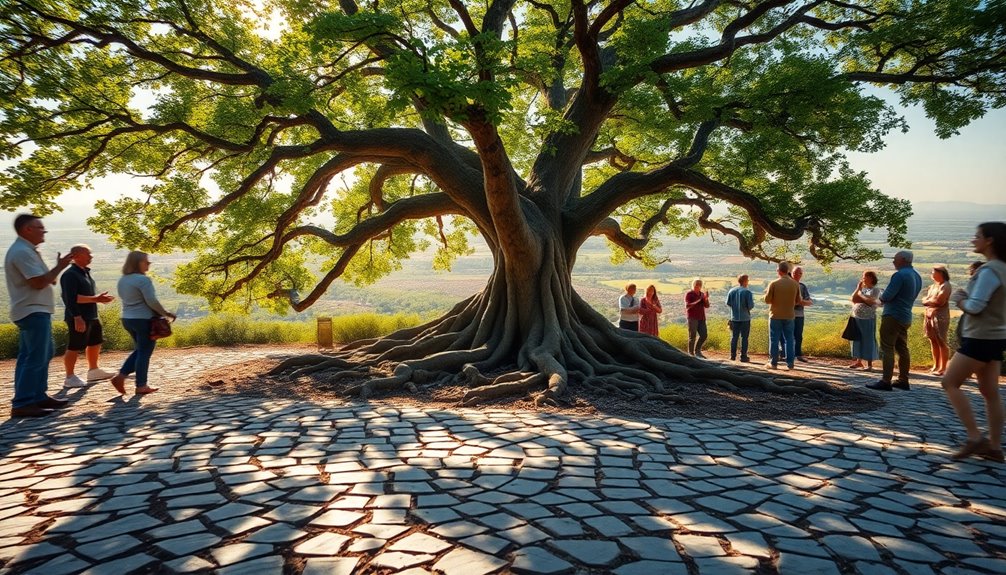
When you explore the Tree of Life, it's easy to fall into common misconceptions that strip away its rich, universal meanings.
Many people focus solely on individual growth, overlooking its profound connections to community and nature.
Additionally, cultural appropriation can cloud the true essence of this symbol, leading to misunderstandings that diminish its significance across different traditions.
Debunk Common Misconceptions
The Tree of Life often gets reduced to simplistic interpretations, leading many to misunderstand its rich and varied significance. While it's often seen solely as a symbol of immortality, it represents the interconnectedness of all living beings and the cyclical nature of life and death. This concept spans numerous cultures, including Christianity, Buddhism, and Indigenous belief systems, each offering unique insights into its meaning.
You might think the Tree of Life only signifies growth and prosperity, but it also embodies resilience, transformation, and the importance of roots and heritage. These elements play a crucial role in shaping personal and collective identity.
Furthermore, some overlook how the Tree of Life illustrates balance and harmony, reflecting the relationship between the physical and spiritual realms.
It's a dynamic symbol, not just a static image. The Tree of Life represents ongoing growth and evolution, emphasizing the continuous journey of self-discovery and learning.
Cultural Appropriation Concerns
Cultural appropriation concerns surrounding the Tree of Life often arise from a lack of understanding about its rich significance in various cultures. When you adopt this powerful symbol without acknowledging its unique narratives, you risk commodifying it rather than appreciating its deep meaning.
The Tree of Life holds distinct interpretations across traditions, such as Celtic, Indigenous, and Buddhist beliefs, each representing profound spiritual significance.
Using the Tree of Life in commercial products or art can diminish its value, reducing it to an aesthetic choice that ignores its origins. This disregard can perpetuate misunderstandings and disrespect towards the cultures that hold the symbol dear.
Before incorporating the Tree of Life into your own work or life, it's crucial to engage with its historical and cultural roots. You should strive to honor the traditions from which it originates, ensuring that your representation respects its varied meanings.
Tree of Life in Rituals
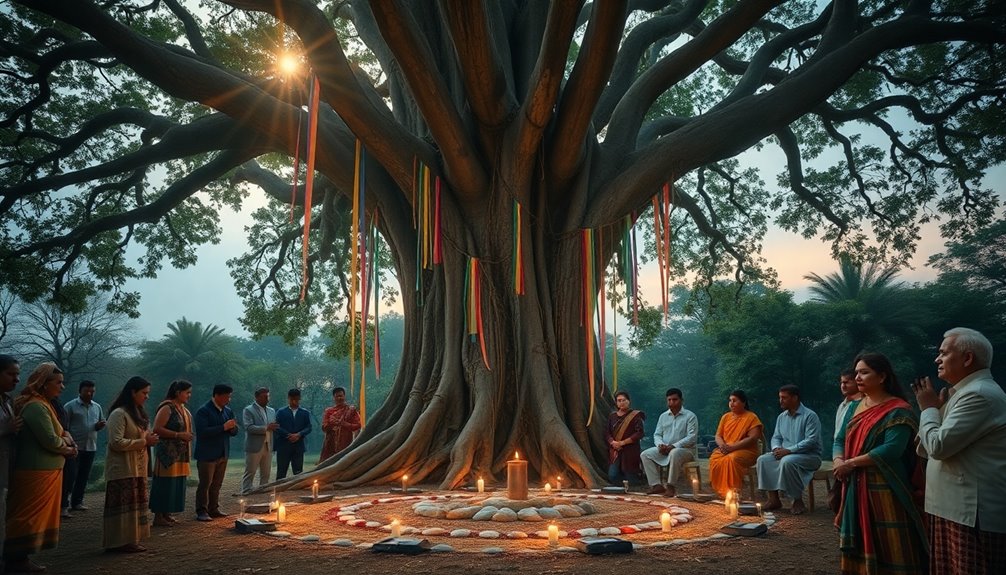
When you participate in rituals centered around the Tree of Life, you often find a space for meditation on personal growth and reflection.
These gatherings can strengthen your faith-based community, fostering connections that enhance your spiritual journey.
Embracing the symbolism of the tree can guide you toward deeper understanding and renewal in your life.
Meditation on Personal Growth
Often, practitioners turn to the Tree of Life in meditation to explore their personal growth and development. This powerful symbol encourages you to reflect on your connections to family, heritage, and the broader universe. By visualizing the Tree of Life, you can see your own growth as branches extending from a strong trunk, emphasizing themes of renewal and transformation.
During meditation, consider the cyclical nature of the Tree of Life. This imagery reminds you that personal growth is a continuous journey, deeply rooted in your experiences and learning. As you meditate, focus on how life's challenges and changes have shaped you. Embrace the lessons learned along the way.
Engaging with the Tree of Life can foster stability and grounding, helping you navigate life's transitions with resilience and hope. Allow the essence of the Tree to remind you that, like its branches, your personal growth stretches towards the sky, reaching for new heights while staying connected to your roots.
Through this meditation, you'll gain insight into your path and cultivate a deeper understanding of your life's journey and potential.
Faith-Based Community Gatherings
Incorporating the Tree of Life into faith-based community gatherings enriches the spiritual experience for all involved. This powerful symbol represents spiritual growth and interconnectedness among members, reflecting the belief that everyone is linked through their faith.
Rituals during these gatherings often feature the Tree of Life, whether through the lighting of candles or creating altars that showcase its imagery. These acts signify the nourishment and sustenance that faith provides to both individuals and the community.
Participants frequently share personal testimonies, representing the branches of the Tree of Life, illustrating how each unique experience contributes to the collective faith. Prayer rituals and blessings often invoke the Tree of Life, emphasizing divine protection and guidance, similar to how a tree's roots symbolize stability and strength.
Seasonal celebrations, like harvest festivals, also embrace the Tree of Life theme, prompting reflection on the abundance and blessings in life.
These gatherings create a space for spiritual growth, allowing you to connect with others and deepen your understanding of faith. Ultimately, the Tree of Life serves as a reminder of the shared journey and the strength found within community gatherings.
Symbol of Interconnectedness
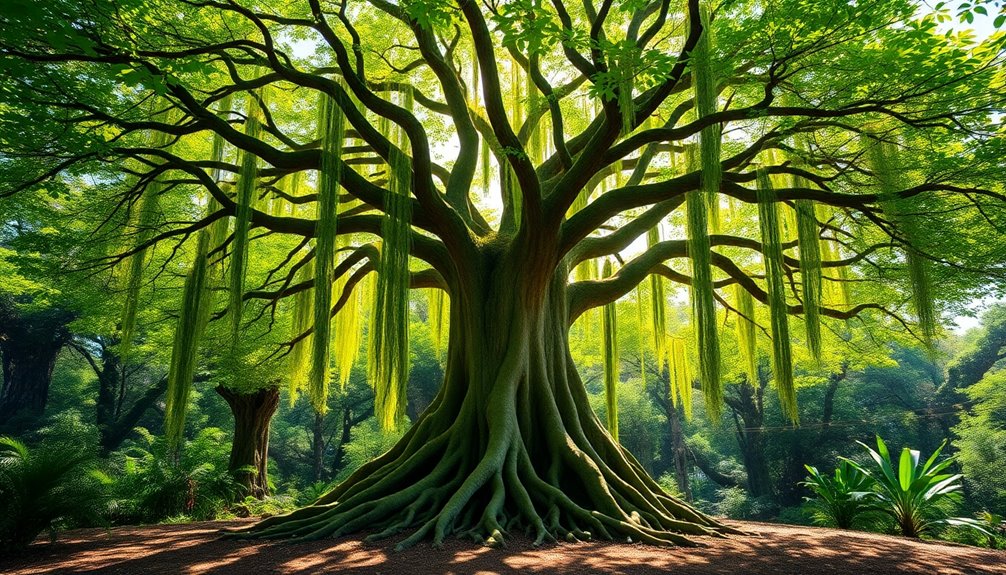
How does the Tree of Life embody the interconnectedness of all living beings? This powerful symbol illustrates that every organism is part of a larger ecosystem, sharing a common origin. In various cultures, the Tree of Life serves as a metaphor for the relationships between humanity, nature, and the divine, emphasizing harmony within those connections.
The circular design of the Tree of Life, with its symmetrical roots and branches, conveys balance and unity. This design reinforces the idea that all life is interdependent and interconnected.
Scientific interpretations further illustrate this concept, revealing evolutionary relationships among species through phylogenetic trees. These trees show how diverse life forms are related through common ancestry, deepening your understanding of interconnectedness.
In spiritual and philosophical contexts, the Tree of Life represents personal and collective growth. It suggests that our evolution relies on our relationships with each other and the environment.
Additional Resources
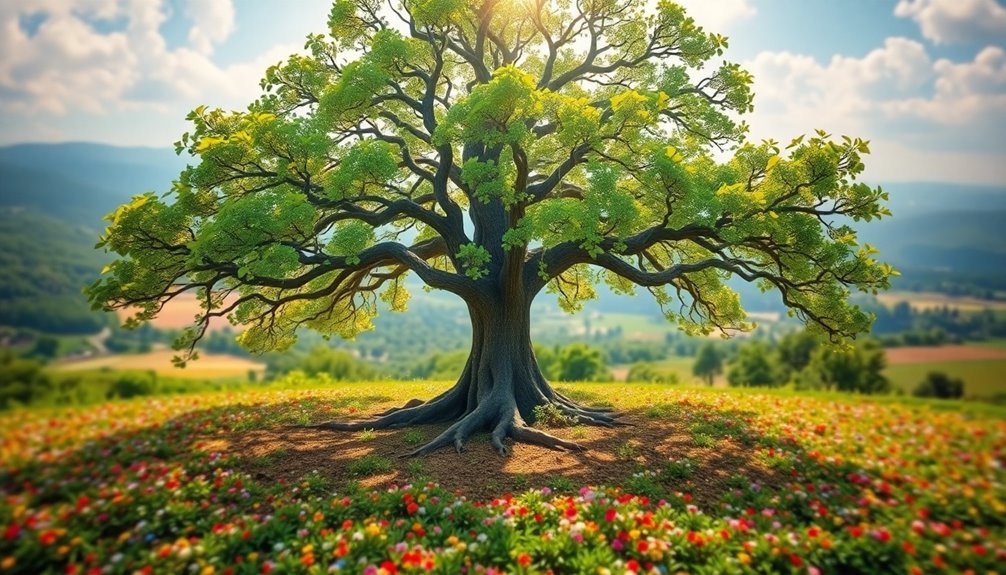
To further explore the profound significance of the Tree of Life, a variety of resources are available that deepen your understanding of its symbolism and cultural interpretations. You might start by diving into the Biblical texts of Genesis and Revelation, where the Tree of Life represents eternal life and divine provision.
Here, you'll find the pivotal moment of Adam and Eve, whose disobedience restricted access to this sacred tree, illustrating the balance between good and evil.
Additionally, consider looking into cultural interpretations, like the Baobab tree in African traditions, which symbolizes life-sustaining properties, or the Kalpavriksha in Hinduism, representing abundance and wishes.
These examples highlight how the Tree of Life transcends individual cultures while maintaining a shared theme of interconnectedness.
Artistic representations, such as Gustav Klimt's mural, further explore the Tree of Life, depicting themes of unity and immortality.
For practical insights, research the Moringa oleifera, known as the "tree of life" in West Africa, which showcases its nutritional benefits and role in combating malnutrition. Furthermore, exploring the essential oils for hair growth can provide insight into how nature offers solutions for both physical and spiritual nourishment.
These resources will enrich your appreciation for the Tree of Life and its universal significance.
Frequently Asked Questions
What Does a Tree of Life Symbolize?
A tree of life symbolizes the deep connections among all living beings.
It represents the cycle of life, death, and rebirth, reminding you of the enduring nature of existence. You might see it as a representation of family lineage, illustrating your heritage and continuity across generations.
In various cultures, it embodies growth, strength, and spiritual renewal, encouraging you to reflect on your journey and the interconnectedness of your experiences with others.
What Is the Biblical Meaning of the Tree of Life?
The biblical meaning of the Tree of Life centers around themes of eternal life and divine provision.
You'll find it first in Genesis, symbolizing God's sustenance for humanity. After Adam and Eve's disobedience, access was denied, illustrating the consequences of sin.
When it reappears in Revelation, it represents healing and renewal, offering hope for believers and highlighting the promise of redemption through faith.
It's a powerful symbol of spiritual nourishment and restoration.
What Is the Moral of the Tree of Life?
The moral of the Tree of Life emphasizes the significance of interconnectedness and the importance of nurturing relationships.
It reminds you that growth and resilience are essential, even in challenging times. You can find hope in transformation and healing, and it encourages you to appreciate your heritage and family connections.
Ultimately, it teaches you that life is a cycle of renewal, inviting you to embrace change and strive for redemption in your journey.
Is It Good to Wear the Tree of Life?
Wearing the Tree of Life can be a great choice for you. It symbolizes interconnectedness and harmony, reminding you of your bonds with nature and others.
Many believe it provides protection and attracts good luck, helping you ward off negativity. Plus, it represents personal growth and renewal, making it a source of inspiration.

